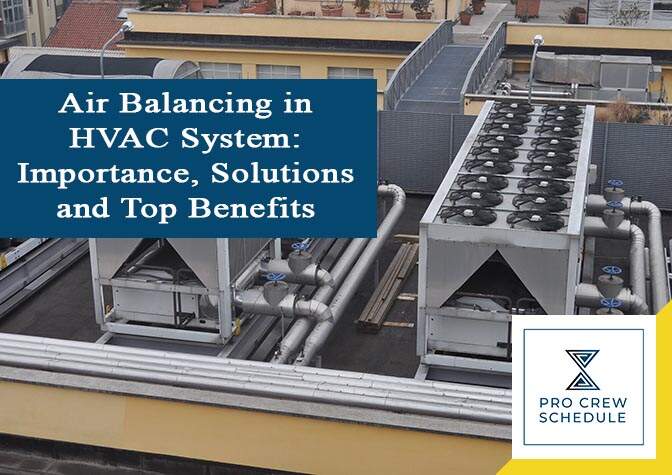HVAC technicians often received countless calls where clients often assumed their heating and cooling systems have been losing efficiency. After a series of inspections, HVAC professionals have discovered an unbalanced airflow in the system. If it is always the case, inconsistent temperatures are prevalent most of the time. This is where the HVAC system benefits the most from air balancing, and this is where HVAC pros have to figure out the best solution for this issue.
In this blog, we will share an overview of HVAC air balancing, including how it is done, its effective solutions, and the benefits it.
The Purpose of Air Balancing in an HVAC system
Basically, air balancing is the primary process of distributing air to each room, including others not currently used spaces. The process is applied whether running the furnace during winter or the air conditioner in the summer. While the work is ongoing, HVAC contractors have to be detailed on the work scope to outline everything is easy. Additionally, air quality systems typically do a better job despite a few factors that can impede it. Most of these factors include dirty filters, wrong thermostat settings, poor installation, and leaks in the ductwork.
Practically speaking, HVAC pros utilize air balancing tests to figure out how much air is coming in and make some adjustments based on the results. Each room has unique or distinct needs. And by balancing the air, an HVAC system works at its peak. For clients, particularly building owners, it will benefit them as it converts to cost-saving energy efficiency. Below is basically how air balancing is carried out within the system.
After modifications and alterations of the room served by the system like moving walls, change in the space’s population and the changes in the space utilization.
- After the initial installation of the HVAC system
- After any modifications of the system itself
- When it has been more than several years already since the last air balance is implemented
- When reports of discomfort tend to increase
Furthermore, air balancing comprises altering the HVAC system’s airflow and every air vent it has according to the ventilation requirements. Most of the air balancing objectives include the quality assurance of comfort for the occupants, the evacuation of contaminants, and air movement through many zones.
How is Air Balancing done?
Often the very reason why certain rooms don’t get enough conditioned air is due to the leaks. When carrying out to perform the air balancing, HVAC professionals start to inspect the ductworks first. The return registers and supply of the heat pumps or furnace and air conditioner will be tested. Also, environmental factors like humidity and temperature are tested, including cold and warm spots.
All of the details will be fed into specialized applications that will analyze the client’s HVAC system’s airflow. It also determines if it requires air balancing and will generate a list of suggested actions for correcting and fixing air imbalances. Below are some common HVAC issues identified after several air balancing inspections.
- Loose duct joints
- Undersized ducts
- Blockages
- Damaged or perforated air ducts
- Ductwork with sharp turns
- Excessively long ductwork
The main goal is to improve the air balance in the indoor space. Below are some of the solutions every HVAC technician often implement to achieve the desired airflow.
- The speed of the blower fan should be adjusted while dampers need to be repositioned. Extra dampers can also be installed if necessary.
- In addition to leaky joints and patching holes, defects in the insulation should also be repaired once and for all. Additional return ducts can also be installed.
- HVAC professionals should replace clogged air filters.
- · After all of these and some other corrections, the air should be tested repeatedly to ensure the right air balance.
- Try a two-degree off-set, especially if there are other factors to consider.
- · Keep electronics far away from the thermostat. Electronic devices will emit heat and can throw off the auto settings.
- Add a second return duct because air obstruction might be due to a bottleneck on the other side of the duct.
- · It is already expected to open the vent register. However, a lot of professionals tend to overlook it. Make some adjustments in such a way that you make adjustments on the dashboard.
- A dirty filter causes the system to function harder, producing unusual output. Change the HVAC filters on a regular basis.
The Five Major Benefits of Air Balancing
Air balancing is a process of testing the heating and cooling system to identify any issues that are causing negative air pressure or uneven airflow. Once determined, the issues can be fixed or corrected so that every space can get the amount of conditioned air it needs. It is also considered necessary that the amount of fresh air is adjusted and checked on a regular basis. Doing so will ensure a consistent intake of oxygen inside the building.
Here are the top five benefits of Air Balancing:
1. Incoming and Outgoing balance sheet
The input and output balance comprises measuring every fan in the facility that will enter the outside air. It usually vents outside also to identify the negative or positive balance of buildings. By following the assessments, suggestions and recommendations are made to maintain conventional pressure within the building.
2. Air Duct Pressurization test
This particular pressurization test is typically performed during the ventilation network installation. It is the type of analysis ensuring the ducting installation and fabrication meet the requirements for leakage for the entire HVAC network.
3. Easy Adjustment of Fresh Air
The amount of outside air that is admitted by the system refers to the fresh air. During the breathing procedure, oxygen is typically replaced by carbon dioxide. However, a much higher carbon dioxide can cause loss of concentration, headaches, dizziness, and even respiratory health issues. Therefore, it is vital to ensure that the amount of fresh air is adjusted and checked regularly to obtain a consistent oxygen intake into the building.
4. Better Indoor Air Quality
Low airflow will allow indoor air contaminants like mold spores and pollen to build up. It could also leave spaces stuffier and stale, which is very advantageous. With a more balanced airflow, your clients and the other occupants will enjoy healthier and fresher-smelling air.
5. Lower energy bills
When the temperature in one area seems not right, it is tempting to lower A/C temperature for the entire building to reimburse. What occupants do not know is that it can waste energy. That is why HVAC professionals need to correct the building’s airflow. Frequently, they suggest clients choose energy-efficient thermostat temperature and still maintain every room comfortable.
How HVAC technicians helped by Project Management Software?
When it comes to project management, details are crucial. The HVAC contractors are expected to responsible for overseeing every aspect of the job, including equipment, resources, labor, crew, paperwork, and other special requirements. To accomplish the job and complete it, the project leaders have to focus on planning. It will keep the details adequately organized to be prepared just when the project starts to commence.
HVAC contractors must stay ahead of the curve and ensure that every participating crew member is on the same page. Here are some top benefits of using this software.
- Timely project completion – project management tools allow HVAC contractors to set an overall deadline, particularly the crew member’s deadlines.
- Seamless communication and collaboration – this software application is designed to be advanced for construction project management. It integrates messaging and commenting so that everything is set-up and done in one place—no more close-up meetings and checking of long email threads to clear up things. The software makes the collaboration and exchanging of details much easier for everyone.
- Clear deadlines and roles – every member’s deadline is listed next to the tasks and they can be aware of how the deadlines impact others’ set of deadlines. Time management is easy when everything involved in the project is laid out clearly. Employees tend to understand more of their actions using it.
- Tracking crew and labor hours – time-tracking feature is the best benefit the software has offered. Project leaders don’t need to monitor them every second because everyone can be tracked anytime. It absolutely saves time and energy.
- Updates and notifications – crew members can select to allow notifications from the software application so that they can quickly know right away the ongoing updates from the project.
- Resource and construction crew management – using this software application allows project leaders to manage and supervise the crew and even the project’s resources.
- Cloud-based storage – accessing files and other project documents are easier since the application is cloud-based. Everything is saved and can be edited within the platform. It is also easy to use, which is very beneficial for some old enough workers to handle mobile devices.
Key Takeaways
The most important reason why your clients request air balancing service is that they look for comfort and healthier indoor space. It is the primary reason why filters should be changed regularly. However, even with a new filter every month, the same dirt can pass through the filters, causing another problem. That is why HVAC professionals should do seasonal check-ups and inspections.








1 thought on “Air Balancing in HVAC System: Importance, Solutions and Top Benefits”
I owned air filter companies in Arizona and I always recommended air balance to my customers . So many problems go over looked and complaints continue in facilities if it is not done.